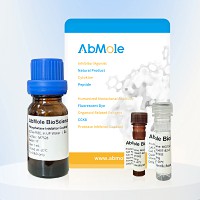All AbMole products are for research use only, cannot be used for human consumption.

Human Siglec-15 is a transmembrane glycoprotein in the Siglec family. Siglec-15 is important for osteoclast formation and TRANCE/RANK Ligand signaling in osteoclasts. Each Siglec contains an N-terminal V-type immunoglobulin domain (Ig domain) which acts as the binding receptor for sialic acid. These lectins are placed into the group of I-type lectins because the lectin domain is an immunoglobulin fold. All Siglecs are extended from the cell surface by C2-type Ig domains which have no binding activity.
Recombinant Human Sialic Acid-binding Ig-like Lectin 15 expressed the target gene encoding Phe20-Thr263 with a mouse IgG1 Fc tag at the C-terminus.
Accession: Q6ZMC9
Endotoxin < 1 EU/µg
Apparent Molecular Weight: 50-70 KDa, reducing conditions
Lyophilized from a 0.2 μm filtered solution of PBS, 150mM NaCl, 0.3% Chaps, 5% Trehalose, pH 7.4.
| Form | Lyophilized powder |
| Solubility (25°C) | Reconstitute the lyophilized powder in distilled water up to 100 μg/ml. |
| Storage | Stored at ≤ -20°C, stable for one year after receipt. Reconstituted protein solution can be stored at 2-8°C for 2-7 days and at -20°C for 3 months. |
[1] Saba Shafi et al. Lab Invest. Development of an immunohistochemical assay for Siglec-15
| Related Receptor Proteins Products |
|---|
| Recombinant Human SIGLEC-7 Protein (HEK293, His Tag)
Recombinant Human Sialic Acid-binding Ig-like Lectin 7 expressed the target gene encoding the Human SIGLEC7 (Q9Y286-1) (Met1-Leu353) was expressed with a polyhistidine tag at the C-terminus. The recombinant Human SIGLEC7 consists of 346 amino acids and predicts a molecular mass of 38.4 kDa. |
| Recombinant Human Siglec-7 Protein (HEK293, C-6His)
Human Siglec-7 encodes a 467 amino acid (aa) polypeptide with a hydrophobic signal peptide, an N-terminal Ig-like V-type domain, two Ig-like C2-type domains, a transmembrane region and a cytoplasmic tail. It binds equally well to both alpha 2,3- and alpha 2,6-linked sialic acid. |
| Recombinant Human SIGLEC-10 Protein (HEK293, mFc Tag)
The recombinant human SIGLEC-10 comprises 763 amino acids and has a calculated molecular mass of 84.60 kDa. A DNA sequence encoding the human SIGLEC-10 (Met17-Thr546) was expressed with the Fc region of mouse IgG2a at the C-terminus. |
| Recombinant Human SIGLEC-10 Protein (HEK293, His Tag)
The recombinant human SIGLEC-10 consists of 540 amino acids and predicts a molecular mass of 59.5 kDa. A DNA sequence encoding the human SIGLEC-10 (Met17-Asn550) was expressed with a polyhistidine tag at the C-terminus. |
| Recombinant Human Siglec-6 Protein (HEK293, C-Fc)
Siglec-6, also known as CD327, mediates sialic-acid dependent binding to cells. Siglec-6 binds to alpha-2,6-linked sialic acid. |
All AbMole products are for research use only, cannot be used for human consumption or veterinary use. We do not provide products or services to individuals. Please comply with the intended use and do not use AbMole products for any other purpose.


Products are for research use only. Not for human use. We do not sell to patients.
© Copyright 2010-2024 AbMole BioScience. All Rights Reserved.
